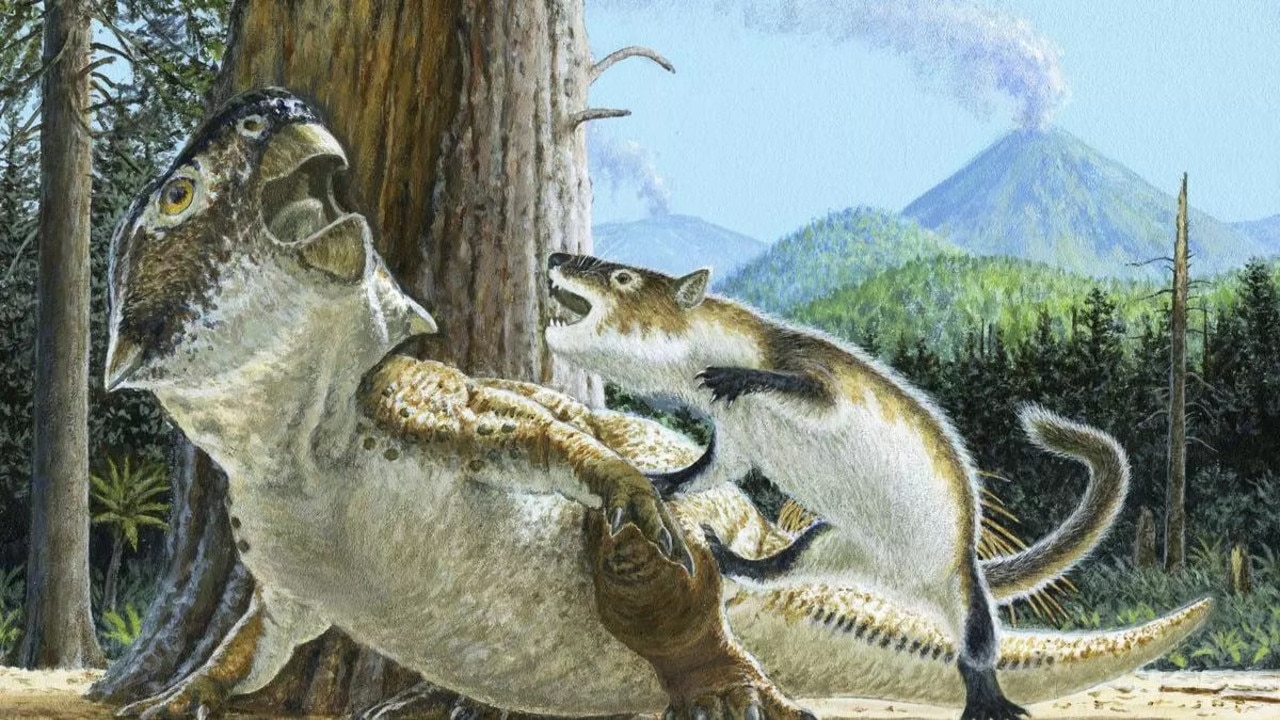Volcanic fossil shows small mammal hunting a dinosaur for dinner
Scientists believe a fossil showing a badger-like creature fighting and biting a much larger dinosaur is a one-of-a-kind discovery

READING LEVEL: GREEN
A rare fossil showing a badger*-like creature sinking its teeth into the ribs of a dinosaur three times its size suggests some early mammals* may have hunted dinosaurs for dinner.
The stone fossil shows the cat-sized mammal chomping down on a small, beaked dinosaur, with their skeletons wrapped around each other. It is believed to be the first fossil found of a mammal and dinosaur fighting each other.
The discovery came from a site known as “China’s Pompeii*,” where mud and ash from long-ago volcanoes buried creatures suddenly as they lived their lives.

“It does seem like this is a prehistoric* hunt, captured in stone, like a freeze frame,” University of Edinburgh palaeontologist* Steve Brusatte, who was not involved with the study, said.
A report this week in the journal Scientific Reports said the two creatures were from about 125 million years ago, during the Cretaceous* period. The mammal is the meat-eating Repenomamus robustus, about the size of a house cat. The dinosaur — Psittacosaurus lujiatunensis — was about as big as a medium-sized dog with a parrot-like beak.
Even though the mammal is much smaller, researchers think it was attacking the dinosaur when they both got caught in the volcanic flow, said study author Dr Jordan Mallon, a palaeobiologist* at the Canadian Museum of Nature.

The mammal is perched on the dinosaur, its paws gripping the reptile’s jaw and a hind limb while its teeth plunge into the ribcage.
“I’ve never seen a fossil like this before,” Dr Mallon said.
The idea that mammals ate dinosaur meat had been proposed before: another fossil showed a mammal died with dinosaur meat in its stomach. But the new find also suggests that mammals may have preyed on dinosaurs several times their size, and didn’t just eat those that were already dead, Dr Mallon said.

“This turns the old story on its head,” Professor Brusatte said. “We’re used to thinking of the ‘Age of Dinosaurs’ as a time when dinosaurs ruled the world, and the tiny mammals cowered* in the shadows.”
The study authors were confident the fossil, found by a farmer in 2012, is real after running lots of rests on the rock samples.
POLL
GLOSSARY
- badger: small animals with flat, wedge-shaped bodies and hair that can be black, brown, gold or white. They like to dig
- mammals: an animal that breathes air, has a backbone, grows hair at some point in its life and the females feed their young with milk
- Pompeii: a preserved Roman city in Italy that was destroyed by the volcanic eruption of Mt Vesuvius in 79CE
- prehistoric: the time before written records
- Cretaceous: period of time between 145.5 and 65.5 million years ago that ended with the extinction of dinosaurs
- palaeontologist: a person who studies fossil animals and plants
- palaeobiologist: a person who studies the biology of fossil organisms
- cowered: crouched down in fear
EXTRA READING
Fierce dinosaur fossil fetches a fortune
Giant sea dragon fossil found in UK
Girl finds 15-million-year-old megalodon tooth
QUICK QUIZ
1. Scientists say this fossil is the first to show what activity?
2. Why is the location where it was found called “China’s Pompeii”?
3. How long ago did the animals live and what was the name of time period?
4. Who found the fossil?
5. Why do scientists describe the fossil as like a “freeze frame”?
LISTEN TO THIS STORY
CLASSROOM ACTIVITIES
1. How are fossils formed?
Do you know how fossils are formed? Use clues in the story or your own knowledge to write a brainstorm answering this question. Then, use your research skills to check if you are right!
Time: allow 25 minutes to complete this activity.
Curriculum Links: English, Science, History
2. Extension
Do you know what types of tests the scientists would have carried out on the fossil to make sure it was real? Use your research skills to find out. Then, write an extra paragraph for this story that will help other kids learn about them.
Time: allow 30 minutes to complete this activity.
Curriculum Links: English, Science, History
VCOP ACTIVITY
1. A Moment In Time
The volcanic lava flow has really captured and preserved this moment in time. Have a go at creating a background story with the events that lead up to this moment. Did the badger-like creature have to stalk his prey? Was the dinosaur alone or just one of the herd caught?
Tell us your thoughts in a unique story.
Then, read your story through and use your VCOP skills to see if you can edit and uplevel it even further.

